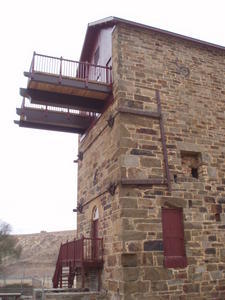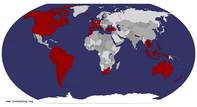Advertisement
Published: January 15th 2007

 Enginehouse at Burra Burra Mine
Enginehouse at Burra Burra Mine
The beautifully restored pump engine house at the Monster Mine. The engine is gone but the house has been turned into a fascinating museum of South Australian mining.Coming off the Stuart Highway back in Port Augusta, it comes as something of a shock to be in urbanised Australia again. It's only taken us a little over a week to drive to Uluru and back from here, but the contrast between Australia's (relatively) densely populated coastline and its almost void interior is a particularly strong one. It's scarcely believable that the boutiques of Melbourne and the outback share the shame country, but share it they do.
We need to get back to Melbourne in a week's time or so but there's a whole lot of the route between Port Augusta and Melbourne that we didn't see on the way up. Our plan is to return to Victoria somewhat further inland - this should take us through some culturally (which includes, naturally,
viticulturally...) important areas of the country.
From Port Augusta we make our way through the drought-stricken farmland to the north of Adelaide. Today the brown hills that roll and roll and roll for miles are used for growing cereal crops and a pasture for the huge numbers of sheep that Australia has become famous for. Despite the rather dull scenery, this part of South Australia has

 Cornwall or South Australia ?
Cornwall or South Australia ?
Not tin, but copper - whatever the metal, a strangely reminiscent landscape.a rich history, thanks to its even richer underground resources - indeed, mining was the backbone of the economy here in the mid-19th century. Not only did this industry provide this corner of the British Empire with large quantities of metal vital to the industrial revolution - copper, especially - but it also had an important effect on the composition of the local population. Indeed the countryside that surrounds the towns of Kapunda and Burra attracted large numbers of Cornish and Welsh immigrants, experienced in the operation of mines.
Our first stop is the small town of Burra, a modest place with a big history of copper mining. For much of the second half of the nineteenth century, Burra's mines satisfied the vast majority of Australia's copper needs and provided 5% of the world's supply of the metal. The town's three copper mines are long closed, but one - the Burra Burra Mine, affectionately known as the Monster Mine - has been preserved as an important part of Australia's heritage. The huge copper lode running beneath Burra was discovered in 1845, and Burra Burra Mine opened the same year. At first, the lack of any processing facilities for the

 Mine resident
Mine resident
The miners are long gone, but this resident of Burra Burra Mine seems to have found a nice spot to spend his life.copper ore meant that the ore had to be shipped all the way back to England for smelting. Much of the equipment needed to mine the copper ore, most importantly the powerful steam engines and pumps needed to keep the deep mine shafts from flooding, were transported to Burra by boat from Cornwall to Adelaide and then by bullock cart to Burra - quite an extraordinary journey for such heavy and unwieldy pieces of machinery...The building that housed the huge steam-powered Cornish beam engine is one of the best-preserved buildings on the site of the mine, and has been turned into a fascinating museum chronicling the history of mining in Australia and of the hardy men who left their lives in England and made the treacherous journey to come and exploit the new colony's mineral wealth.
Mining wasn't the only tradition the West Country miners brought to this part of Australia. In addition to the excitement of beam engines and boilers, the Cornish miners just couldn't live without their scones and cream teas. One of Burra's many beautifully preserved mid 19th century shophouses is home to a tea shop-cum-antique shop-cum-bookshop where - on more than one occasion I am

 Quietly rusting...
Quietly rusting...
A small wagon used to transport ore around the mine workings.ashamed to admit - we indulged in delicious scones slathered (mmmm,
slathered) in homemade jams and lovely lovely thick cream....Right, daydreaming over. Apparently they say an hour's uphill walking burns something like 600 calories so the walk around Kata Tjuta burned off those cream teas - in advance, that is...One other most welcome West Country delight that got off the fast steamers with the miners all those years ago was cider. Up a steep and twisty unmade track just outside the town, Thorogoods of Burra is a nationally famous cidery which produces not only classic cider but apple beers, apple wines and even an apple champagne ! We certainly couldn't leave without a bottle of the champagne, which was quite, quite delicious sipped by the stream than ran along the back of our campsite in Burra. Heaven !
From Burra we headed south, from dairy and wheat territory back into vine country. Here, to the east of Adelaide, are two of Australia's best known wine producing areas - the Clare and Barossa Valleys. First on the road south from Burra is the Clare Valley, famous worldwide for its Reisling. The majority of the wineries in Clare are located off

 Crumbling away
Crumbling away
As the mine became increasingly uneconomical to exploit, it was rapidly abandoned.a short stretch of road between the town of Clare proper and the village of Auburn to the south. The
Riesling Trail which follows this road is an extremely popular cycling route (for breathalyser-related reasons one might suppose). Having already overindulged in McLaren Vale we visited just one winery in Clare, the Sevenhill winery, located in a tiny hamlet of the same name. Sevenhill was founded by - of all people - Austrian Jesuits who came to South Australia on mission work. Today the winery is dominated by Saint Aloysius Church which was built by the Jesuits - the winery itself originally produced communion wine, but production later branched out (oh, it did, did it ? Good old Jesuits) and the vines here produce, amongst others, Riesling. The underground cellars, with their gargantuan casks of sweet communion wine - which is still made here and exported all over the Asia-Pacific region - are open to visitors and make for an interesting wander. We couldn't resist trying a bottle of Gewurztraminer. We go through each cellar door promising not to buy anything but it's just too difficult ! That evening we treated ourselves (because so far over the past couple of

 Old pipes
Old pipes
These iron sections of pipe ran downwards from the engine house - the system of rods and tubes used to pump the water out of the mine shafts ran through these.days, I'm sure you would agree, we
have been denying ourselves) to dinner at the
Rising Sun, a beautiful old pub in Auburn that is well known throughout the state for its delicious food. And delicious it was, although a swarm of flying ants of truly Biblical proportions provided us with a little additional, although unwelcome, protein...
The following morning we set off towards the Barossa Valley, another relatively small wine-producing area with a clout out of all proportion to its size. Loosely centred around the town of Tanunda, the Barossa Valley was first settled by German immigrants in the 1840s. Mostly from the region of Prussian Silesia (somewhere in southern present-day Poland), the regions first European settlers called it
Neu-Schlesien. Today the German influence is not immediately present, although we were quick to discover Tanunda's
wursthaus and a variety of German known as
Barossadeutsch has left Australian English with a few loanwords (apparently, since I am unable to find evidence of any such words). Between the towns of Tanunda and Nuriootpa (I know - even the locals can't say it) we discovered a wonderful little gourmet food shop run by a certain Maggie Beer - we had never

 A long way from home
A long way from home
Possibly brought all the way from Cornwall over 150 years ago, one of the boilers which supplied the mine engines with steam. Water pumps, rollers, crushers - all steam powered.heard of her but can only guess she is the Australian equivalent of Jamie Oliver. Whoever she is her shop is a fantastic foodie place to browse in and we picked up a few goodies to have for lunch: some local cheese and sausage, and most intriguingly of all some cabernet sauvignon paste, a sort of local
membrillo said to go well with cheese. Tasty ! Rather ashamed at having something like five bottle of assorted wine, cider and goodness knows what else rattling above our heads in the campervan, we limited our cellar door visits to the beautiful Yalumba winery in Angaston - "tasting only". Obviously we walked out with another bottle to keep the others comany. Whoops.
The drive south from the Barossa through Lobethal and Hahndorf (German immigrants, you say ?) was particularly picturesque, with rolling green hills and herds of dairy cows giving the landscape a very definite Alpine feel. We spent the night in Hahndorf, a pretty town with a very large, erm, jam factory. We had intended to spend our last remaining days on the road back to Melbourne, passing through the Grampian National Park and the "gold towns" north of Melbourne. The

 Open cut mine
Open cut mine
As the copper lode was eaten away by the miners, the mine was converted to open cut to extract the maximum possible amount of ore.plan was somewhat scuppered by the fact that the Grampians had been devastated the year before by vicious bushfires (well done Lonely Planet for keeping your guidebooks updated) that had left most of the walking tracks closed. As for the Victorian gold fields, we did stop in Ballarat where we spent the night, but the weather was so miserably freezing (we actually had to buy ourselves two fleecy tops - in November, in Australia...) that we gave up and decided to cut straight south and drive home along the Great Ocean Road instead, taking in some familiar sights but the other way round. It turned out to be a great idea, with the seascapes even more astonishing than we remembered.
Over the past four weeks Smoggie had become a good friend - despite his iffy clutch and gas-guzzling antics, we had grown very fond of our little campervan and it was not without a little twinge of regret that I dropped him off, back in the dreary suburbs of Melbourne again after his adventure to Uluru and back. Poor Smoggie - hopefully his next owners will take good care of him. Good boy, Smoggie.

 Conflicting advice...
Conflicting advice...
Where to turn ? In case you are wondering, which you should be, we went left.
Advertisement
Tot: 0.107s; Tpl: 0.016s; cc: 12; qc: 29; dbt: 0.0416s; 1; m:domysql w:travelblog (10.17.0.13); sld: 1;
; mem: 1.1mb
























